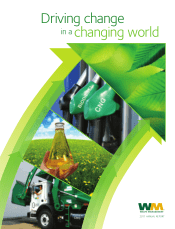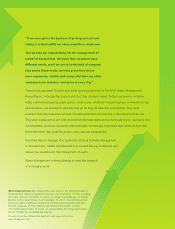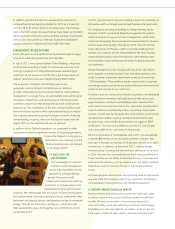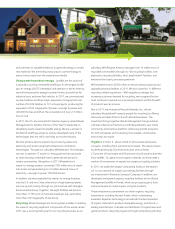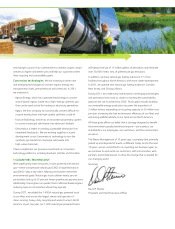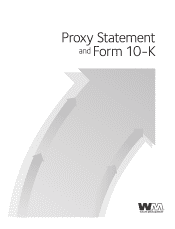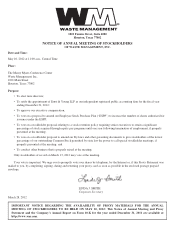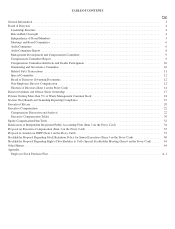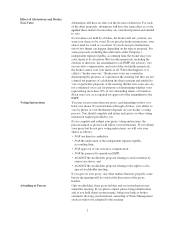Waste Management 2011 Annual Report Download - page 5
Download and view the complete annual report
Please find page 5 of the 2011 Waste Management annual report below. You can navigate through the pages in the report by either clicking on the pages listed below, or by using the keyword search tool below to find specific information within the annual report.
and use them as valuable feedstock to generate energy or create
new materials. We are finding many ways to use technology to
extract more value from the materials we handle.
Using waste to produce energy. Landfills are the source of
a naturally occurring, renewable landfill gas. As the largest landfill
^Xj$kf$\e\i^pC=>K< [\m\cfg\iXe[fg\iXkfi`eEfik_8d\i`ZX#
we are harnessing this energy to power homes, provide fuel for
industrial uses, and even fuel vehicles. In 2011, we commissioned
j`oe\n]XZ`c`k`\jXe[k_i\\dXafi\ogXej`fej#Yi`e^`e^k_\kfkXc
eldY\if]C=>K<]XZ`c`k`\jkf(*(XZk`m\gifa\Zkj#gif[lZ`e^k_\
\hl`mXc\ekf]-(,d\^XnXkkjf]gfn\iÆ\efl^_kfgfn\ifm\i
+-'#'''_fd\jXe[fūj\kk_\Zfejldgk`fef]fm\i)%*d`cc`fe
tons of coal.
In 2011, the U.S. Environmental Protection Agency named Waste
Management its Industry Partner of the Year for leadership in
developing waste-based renewable energy. We are a pioneer in
k_\Ó\c[f]cXe[Ócc^Xjgifa\Zkj#Xe[n\[\m\cfg\[dXepf]k_\
technologies that are still in use today across the industry.
We also produce electrical power by processing waste into
electricity and steam using high temperature combustion
technologies. Through our subsidiary Wheelabrator Technologies,
n\fnefifg\iXk\(.nXjk\$kf$\e\i^pgcXekjk_Xklj\nXjk\
as clean-burning, renewable fuel to generate electricity for
nearby communities. Altogether, in 2011 Wheelabrator’s
nXjk\$kf$\e\i^pgifa\ZkjZfem\ik\[.%--d`cc`fekfejf]nXjk\
`ekfjk\XdXe[^\e\iXk\[lgkf+%,Y`cc`feb`cfnXkk_flijf]
\c\Zki`Z`kpÆ\efl^_kfgfn\i.',#'''_fd\j%
In addition, we have expanded our waste-to-energy business
into the U.K. and into China, where four of eight planned plants
Xi\efnlgXe[ilee`e^k_ifl^_fliaf`ekm\ekli\n`k_J_Xe^_X`
Environmental Group. Together, the eight facilities will process
dfi\k_Xe((#.,'kfejf]dle`Z`gXcnXjk\g\i[Xp#^\e\iXk`e^
more than 210 megawatts of electricity.
Recycling. Waste Management has long been a leader in realizing
the value of recycling significant components of the waste stream.
2011 was a record growth year for our recycling business as our
subsidiary WM Recycle America managed over 10 million tons of
recyclable commodities through its 100 recycling facilities, nine
electronics recycling facilities, two LampTracker® facilities, and
extensive third-party processing network.
ND`em\jk\[Zcfj\kf(''d`cc`fe`ee\ngifZ\jj`e^ZXgXZ`kpXe[
upgrading existing facilities in 2011. We also closed on 11 different
recycling-related acquisitions. With regulatory changesand
increasing customer demand for recycling, we recognize that we
must continue to expand our processing footprint and the breadth
of products we can process.
Also in 2011, we invested in Recycle Rewards, Inc., whose
subsidiary Recyclebank® rewards people for recycling by offering
discounts and deals from local and national businesses. The
investment brings together Waste Management’s large national
curbside collection infrastructure with Recyclebank’s vast online
community and incentive platform, enhancing growth prospects
for both companies and motivating more people, communities
and schools to recycle.
Organics. In the U.S., about a third of all municipal solid waste
is organic, including food, yard and wood waste. This waste stream
has been growing by 20 percent per year, and currently
)%,g\iZ\ekf]]ff[nXjk\Xe[-,g\iZ\ekf]pXi[nXjk\`j[`m\ik\[
from landfills. To capture more organic materials, we have made a
number of investments to expand our organics recycling solutions.
In 2011, we added the largest composting facility in the eastern
U.S. to our network of organics processing facilities through
our investment in Peninsula Compost Company. In addition, we
developed andopened organics recycling facilities at two Waste
DXeX^\d\ekcXe[Óccj`e=cfi`[X#n_`Z_Xi\gifZ\jj`e^pXi[#]ff[
and wood waste to create organic compost products.
These investments complement our other organics recycling
investments, including Harvest Power, which is developing
anaerobic digestion technology to accelerate the decomposition
of organic materials to produce renewable energy; andGarick, a
leading manufacturer, marketer and distributor of organic lawn and
gardenproducts. Recycling organics through composting and other

